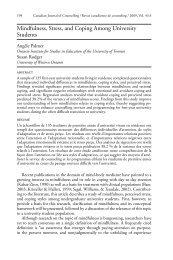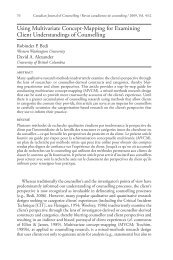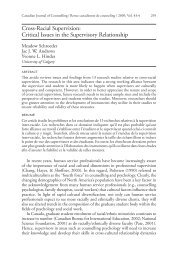PROFESSIONAL COUNSELLOR - Mental Health Academy
PROFESSIONAL COUNSELLOR - Mental Health Academy
PROFESSIONAL COUNSELLOR - Mental Health Academy
You also want an ePaper? Increase the reach of your titles
YUMPU automatically turns print PDFs into web optimized ePapers that Google loves.
THE <strong>PROFESSIONAL</strong> <strong>COUNSELLOR</strong><br />
03 2008<br />
Third, the individual is able to observe the<br />
problems, struggles, behaviours, interaction styles, and<br />
coping mechanisms of the others in the group. He is<br />
then able to use this information as a yardstick for<br />
comparing his own behaviours. From this a group<br />
member can assess his<br />
own abilities and<br />
disabilities and consider<br />
possibilities for personal<br />
change.<br />
Closely linked with the<br />
third advantage is the<br />
fourth, which is<br />
facilitation of the<br />
individual growth process.<br />
The support of the group<br />
can be an enhancing<br />
factor in self-exploration<br />
and introspection<br />
(Lieberman, 1990b;<br />
Posthuma & Posthuma,<br />
1972). Feeling, caring,<br />
and respect from others<br />
“The individual<br />
is able to<br />
observe the<br />
problems,<br />
struggles,<br />
behaviours,<br />
interaction styles,<br />
and coping<br />
mechanisms of<br />
the others in the<br />
group.”<br />
can go a long way in promoting the self-confidence<br />
necessary to attempt new and different ways of<br />
behaving.<br />
The final advantage of the group format for both<br />
counselling and therapy is the obvious one of<br />
economics. Having several clients meet together with<br />
a group leader rather than meeting individually with a<br />
therapist or counsellor saves time and money (Davies<br />
& Gavin, 1994).<br />
Group Therapy and Change<br />
Yalom (1985) discusses “therapeutic factors”<br />
(originally called “curative factors”) which he says<br />
operate in all types of therapy groups, with different<br />
factors being emphasized in any given group<br />
depending on the goals and composition of the group<br />
and the approach that is being used. It is also true that<br />
in some situations clients must deal with certain<br />
factors before they can benefit from others (Bonney,<br />
Randall, & Cleveland, 1986). Other authors have<br />
identified “helping factors” (Schultz, 1993;<br />
Schwartzberg, 1993) in support groups that appear<br />
similar in many respects to Yalom’s therapeutic factors.<br />
Yalom notes that many of the factors are<br />
interdependent and that some factors represent<br />
conditions for change while others are actually<br />
mechanisms of change. Yalom’s factors have been<br />
extensively cited and investigated, including recent<br />
research that demonstrated that the levels of<br />
therapeutic factors tended to increase over the life of<br />
the group (MacNair-Semands & Lese, 2000).<br />
MacKenzie (1987) established that outcome<br />
measures evaluating the usefulness of the therapeutic<br />
factors, when taken retrospectively, differed from<br />
results obtained while members were still active in the<br />
group. Descriptions of the ten primary categories of<br />
therapeutic factors follow (Yalom, 1985).<br />
1. Imparting of Information. The type of information<br />
imparted in groups depends on the type of group,<br />
the leader, and the members. Included may be<br />
advice, suggestions, guidance, interpretations, or<br />
didactic instruction about a certain theoretical<br />
approach such as transactional analysis or<br />
cognitive restructuring. In task groups, such as<br />
assertiveness-training, life-skills, or goal-setting, it<br />
is likely that the leader will give information and<br />
instructions to the members before commencing<br />
the activity.<br />
In using a didactic approach, one must be careful<br />
that the group does not become essentially a<br />
“class” and hence foster a dependence on the<br />
leader to “tell us what to do.” This caution is<br />
basically supported by the work of Block and<br />
Crouch (1985) who found guidance to be one of<br />
the least helpful therapeutic factors. In<br />
educational domestic violence groups for men,<br />
however, Schwartz and Waldo (1999) found that<br />
imparting information and development of<br />
socialising techniques were the most useful<br />
therapeutic techniques. Members appeared to<br />
appreciate the opportunity to learn more about<br />
their condition from both professionals and their<br />
peers. In a study with clients in a psychiatric day<br />
treatment center Falk-Kessler, Momich, and Perel<br />
(1991) found that whereas group leaders found<br />
guidance to be valuable the group members did<br />
not.<br />
2. Installation of Hope. It is crucial that the members<br />
see the group as a helpful-hopeful treatment<br />
method. Many groups are open, so new members<br />
are being accepted as others approach discharge.<br />
This process offers the opportunity for those<br />
members who have gained and improved from<br />
the group experience to share their experiences<br />
with the newer members. If Joe can say, “When I<br />
first came into this group I was scared and didn’t<br />
think I had anything worthwhile to say, so I was<br />
pretty quiet. But now I think I talk as much as<br />
anyone,” then this can give encouragement and<br />
hope to a timid, withdrawn member that he too<br />
may be able to reach that point. Yalom (1985)<br />
actually encourages leaders to “exploit” this factor<br />
by pointing out changes and improvements<br />
members have made as a means of offering hope<br />
to others. When members are dealing with<br />
uncertainties about the future, Spencer, Davidson,<br />
and White (1997) see the development of hope as<br />
a collaborative effort.<br />
3. Universality. Each group member is different,<br />
having his very own set of unique problems.<br />
Members often believe that no one else could<br />
possibly have problems that are as bad as theirs.<br />
However, as members begin to talk in the group<br />
4

















